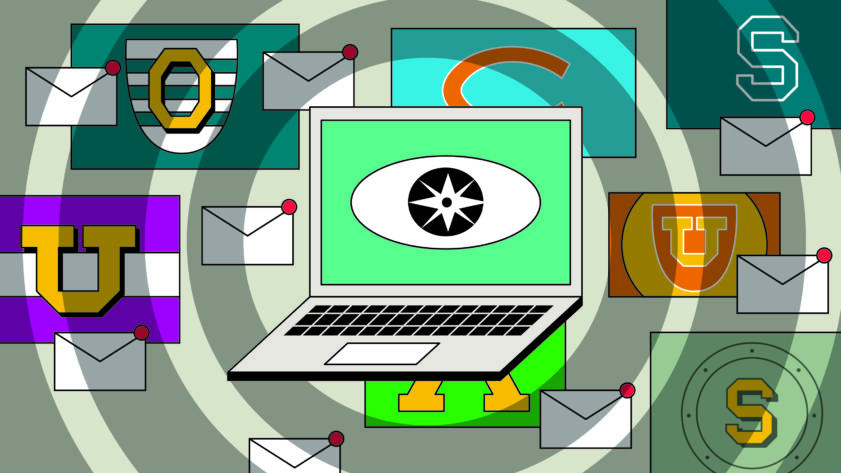For nearly two-thirds of American high schoolers Naviance software is an integral and nearly unavoidable part of the college research and application process. For colleges and universities, it’s also a targeted advertising platform with a captive audience of millions of students looking to make one of the largest financial investments of their lives.
The Markup examined the Naviance accounts of several students who granted us access and reviewed contracts between 10 universities and Intersect, a sister company to Naviance responsible for selling advertising campaigns on the platform. We uncovered how Naviance gathers data through its college guidance software and then allows colleges and universities to target students with paid advertisements encouraging them to enroll.

Machine Learning
This Private Equity Firm Is Amassing Companies That Collect Data on America’s Children
Vista Equity Partners has been buying up software used in schools. Parents want to know what the companies do with kids’ data
The platform allows admissions officials to select what kinds of students will see their recruiting messages based on the students’ location, academic “ability,” the majors they’re interested in, and even their race. In one instance, The Markup found a university that deliberately advertised only to White students through Naviance. Several other schools used the platform to target students of all races in some states but only White students in others.
The software has become ubiquitous in the college search process. More than 10 million students use it to submit their college applications, request teacher recommendations, and submit transcripts. They research colleges and universities using Naviance’s SuperMatch feature, which calculates a “fit score” designed to show students how well aligned they are with a particular school.
They use the software’s scattergram feature to compare their test scores and GPAs to previously admitted students from their own high school. And they receive messages through Naviance about schools that might be good matches for them.
Some of those messages, The Markup found, are actually paid advertisements from the schools.
“There’s some social engineering at play that feels really concerning,” said Ceceilia Parnther, a St. John’s University professor who studies higher education leadership. “I see it being an electronic form of gatekeeping.”
Naviance and Intersect are owned by PowerSchool and are key parts of an ed tech empire—largely owned by the private equity firm Vista Equity Partners—that is exerting significant influence over students from kindergarten through college graduation.
PowerSchool declined to answer many of The Markup’s questions for this story, but in a brief email, Darron Flagg, the company’s chief compliance and privacy officer, wrote that the feature that allows colleges to target students with advertisements based on their race was phased out in 2019—two years before PowerSchool acquired the companies.
There’s some social engineering at play that feels really concerning.
Ceceilia Parnther, St. John’s University
“The Intersect product does not allow matching criteria that excludes under-represented student groups,” Flagg wrote in an email.
That statement is directly contradicted by documents The Markup obtained through public records requests.
Students The Markup spoke to for this story said they felt misled and had often been confused about why they were receiving messages through Naviance from schools in which they had expressed no interest.
“I thought the results I was getting were really weird,” said Alexandra Raphling, a senior at Santa Monica High School, in California. “They weren’t consistent with my grades, they weren’t consistent with what I put in [as search criteria].… It kind of just shows that Naviance doesn’t have the best interest of students using the software at heart.”
Race-Based Advertisements
In August 2021, the University of California San Diego purchased an advertising campaign through Intersect that allowed it to send targeted messages through Naviance to students who had used the platform to research competitor institutions—as designated by UC San Diego—and to “racial or ethnic minorities,” according to a contract obtained by The Markup.
The $142,000 contract includes a campaign that specifically targets “racial or ethnic minorities” in California who used Naviance to research the University of Southern California, Arizona State University, or UC Irvine.
See the documents here.
UC San Diego declined to comment.
The contract is set to run until 2023. It was signed five months after PowerSchool acquired Naviance and two years after the race-based targeting feature was supposedly phased out.
The Markup obtained contracts showing targeted advertising campaigns from nine other universities.
In addition to their contracts, City Colleges of Chicago and Northern Illinois University provided user manuals, copyrighted 2020, that explain how school officials can pick from “diversity filters” when selecting which students will see their recruiting ads. City Colleges of Chicago also provided an Intersect demonstration video that shows a narrator selecting from a list of racial identities and unclicking a box labeled “American Indian or Alaska Native”—meaning students who identify as members of those groups would not receive recruiting messages from the school.
The Intersect website currently states that clients can use the service to “find students who fit specific demographic variables (race, ethnicity, geography, class year, attendance at an under-represented school) and present messages about your institution to students who possess those characteristics.”
When The Markup presented its findings to PowerSchool and asked about Flagg’s earlier comments, spokesperson Madeline Willman wrote in an email, “PowerSchool stands by what has been provided as factual.”
Contracts from the University of Kansas show how the targeted advertising service the companies market as a means to increase student body diversity can actually be used to do the opposite.
In 2015, for example, the university paid for a year-long Naviance advertising campaign that targeted only White students in Kansas, Texas, and Minnesota.
That purchase occurred before PowerSchool acquired Naviance, but the University of Kansas continued to use Naviance-targeted ads through at least June 2021. The later contracts do not specify whether the school targeted students based on race, and the University of Kansas did not respond to requests for comment.
In 2016, contracts obtained through public records say the University of Southern Maine purchased a Naviance campaign that targeted White, Black, and Hispanic students in Massachusetts. But its ad campaigns in Maine, New Hampshire, and Vermont targeted only White students.
The University of Southern Maine did not immediately respond to requests for comment.
The same year, the University of Massachusetts Boston purchased Naviance advertising aimed at both White and “other” students in New Jersey and New York. But in Connecticut and New Hampshire, it targeted only White students.
“UMass Boston uses many recruiting strategies … to reach interested high-school-aged students with an aim toward growing diversity in our student body,” DeWayne Lehman, a spokesperson for the university, wrote in an email. He did not answer questions about why the university would target only White students in certain states.
“You Can Pretty Much Not Escape”
Many colleges and universities have traditionally directed their advertisements using lists of prospective student names purchased from the ACT and from the College Board, which administers the SAT. But fewer high school students are taking those standardized tests.
In many places, the tests were canceled because of COVID-19. And even before the pandemic, universities were adopting test-optional application policies that did not require students to submit test scores. As a result, schools have been searching for new sources of data to fuel their marketing.
10M+
Number of students who use Naviance
Source: Naviance
EAB—which is owned by Vista Equity Partners, the same firm that holds a significant stake in Naviance’s parent company, PowerSchool—is currently the exclusive reseller of Intersect’s targeted advertising service. In its marketing material, EAB has presented its access to students through Naviance as a way for colleges and universities to find valuable advertising leads and make up for the loss of data from the ACT and SAT. “Unrivaled Reach: Influence and Engage Top Prospects via Naviance,” reads one recent EAB marketing presentation.
Naviance says that more than 10 million students spread across 40 percent of U.S. high schools use its services. That’s about two thirds of the 15.3 million students who were enrolled in high school in 2020, according to the U.S. Department of Education data.
Some districts, like Pittsburgh Public Schools, have made Naviance the mandatory cornerstone of their college and career readiness programs.
Beginning in third grade, Pittsburgh students must complete at least two lessons or surveys tied to their Naviance account each year, according to a curriculum plan obtained through a public records request. In high school, Pittsburgh students are required to use Naviance’s SuperMatch college search feature, request materials from schools through the platform, and add at least one school to their “Colleges I’m Applying to” list, according to the document.
Pittsburgh Public Schools did not respond to a request for comment.
The surveys ask students to respond to prompts like “It is very important to me that other people see me as a successful person” and “I like to lead and persuade people and sell things and ideas.” In some cases, students take the surveys once in middle school and are not allowed to change their answers at any point in the future. In its user manuals for students, Naviance encourages students to use the survey results to determine their career goals and course plans.
Some districts, like Ann Arbor Public Schools, also use Naviance to administer their own custom surveys about students’ post-high-school plans. They ask students to answer questions like “How are you planning on paying for college?”—information that would be valuable to schools considering which prospective recruits to focus their recruiting efforts on.
The Markup did not find any evidence that Naviance was using students’ survey answers to help target advertisements.
In order to graduate, you can pretty much not escape the use of Naviance.
Cassie Creswell, parent
Kids and parents in several districts told The Markup that their schools required students to use Naviance to take career aptitude surveys, request teacher recommendations, submit applications, and research colleges, even if they had already identified the schools they intended to apply to.
“In order to graduate, you can pretty much not escape the use of Naviance,” said Cassie Creswell, a Chicago parent.
That level of reach has made the platform highly attractive for schools like New Jersey City University, one of the institutions that pays Intersect for advertising services, that are competing for a shrinking number of potential students.
Jose Balda, NJCU’s director of admissions, said that 382 freshmen—more than a third of the school’s incoming class in 2020—connected with NJCU through Naviance (although that may not have been the only way they discovered the university).
“This is essentially giving students the opportunity to add us to their shopping list,” Balda said.
A former Naviance account executive, who spoke on the condition of anonymity to protect his current job, put it a different way: “It’s a pay to play kind of idea, and I don’t think parents know that, but all the universities knew that.”
Empowering Students
The former employee said that, despite the disguised advertising, he believes Naviance provides a valuable service to many students, especially those who have fewer resources or less familial experience with the college search process.
PowerSchool says Naviance empowers students with data that helps them make informed decisions about their post-high-school plans and tools to follow through on those plans.
Research into students’ use of Naviance suggests that increased use of the software correlates with increases in college application rates, but its ultimate effects are complicated.
In 2020, Christine Mulhern, then a Harvard University education researcher, investigated the scattergram charts that Naviance displays to students as they research colleges. The charts show students how their GPA and test scores compare to peers from their school who were accepted by a particular college.
Mulhern found that students were 20 percent more likely to apply to a college if they first saw a Naviance scattergram depicting the grades and test scores of previously admitted students. Other research has also shown that increased use of Naviance correlates with higher college application rates.
Viewing scattergrams had a particular impact on students of color, correlating with increased four-year-college enrollment rates for students who are Black, Hispanic, or received free or reduced lunch, Mulhern found. But the study also showed that those students who viewed Naviance scattergrams were “less likely to apply to reach colleges and more likely to attend a safety school” and that “it is probably not optimal for students to respond so strongly to admissions signals” like the GPA and test scores that the scattergrams show.
Another study, conducted by University of California Irvine professor Roderic Crooks, examined how students in a Los Angeles high school that was 94 percent Latino and 6 percent Black responded to the introduction of Naviance and a school mandate that they use the platform to apply to at least four colleges.
He found that students rebelled against software-enabled surveillance of the application process, in some cases uploading fake applications to Naviance in order to meet their quotas and avoid expulsion.
“At the level of the school, at the level of the user, I think the benefits are quite limited,” Crooks said in an interview. “The benefits accumulate elsewhere.… Naviance wound up with this mountain of data through its activities that then became a saleable, actionable asset. Once these channels for aggregating data are created, then you start to see the companies pivot and start to be about something else.”
Correction
A previous version of this story stated that an ad campaign was purchased by the University of Maine. It was purchased by the University of Southern Maine.





